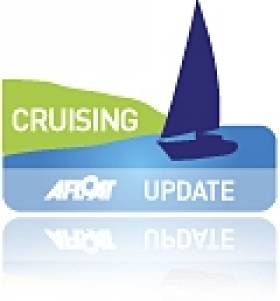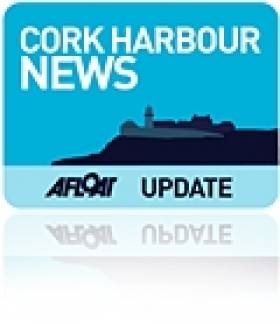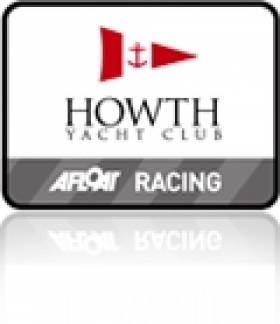Displaying items by tag: Joe English
Ireland Hit The High Spot In The Sydney Hobart Race 23 Years Ago
#rshyr – Ireland's fascination with the Rolex Sydney-Hobart Race moved onto a new plane in 1991, when a three-boat Irish team team of all the talents had a runaway win in the Southern Cross Series which culminated with the 628-mile race to Hobart. The three skipper/helmsmen who led the squad to this famous victory twenty-three years ago were Harold Cudmore, Joe English and Gordon Maguire, all on top of their game.
These days, the incomparable Harold Cudmore is still a sailing legend, though mostly renowned now for his exceptional ability to get maximum performance out of large classics such as the 19 Metre Mariquita, sailing mainly in European waters.
But sadly, Joe English passed away just eight weeks ago in November in Cork, much mourned by many friends worldwide. Yet for Gordon Maguire, the experience of sailing at the top level in Australia was life-changing. He took to Australia in a big way, and Australia took to him as he built a professional sailing career. And he's still at it in the offshore racing game as keenly as ever, with 19 Sydney-Hobarts now logged, including two overall wins.
He raced the challenging course of this 70th 2014 edition as sailing master of the Carkeek 60 Ichi Ban, a boat which is still only 15 months old, having made a promising though not stellar debut in 2013's race. Also making a determined challenge was the First 40 Breakthrough with a strong Irish element in the crew led by Barry Hurley, fresh from the class win and second overall in October's Rolex Midde Sea Race.
And high profile Irish interest was also to be found aboard the Botin 65 Caro, the record breaker in the 2013 ARC Transatlantic Race. She's a very advanced German-built "racer/cruiser" aboard which Ian Moore - originally of Carrickfergus but longtime Solent-side resident - was sailing as navigator.
W M Nixon casts an eye back over the 2014 race, whose prize-giving took place in Hobart yesterday, and then concludes by taking us back to 1991, when Ireland moved top of the league in the Offshore Racing World Team Championship on the same occasion some 23 years ago.
It has to have been the most keenly-anticipated debut in recent world sailing at the top level. At last we'd get to see how Comanche could go in serious sailing. When the 70th 628-mile Rolex Sydney-Hobart Race started on Friday December 26th at 0200 hours our time, 1300 hrs local time in Sydney Harbour, this was for real. There may have been 117 boats of all shapes and sizes from 33ft to 100ft in the fleet. But all eyes were on the limit-pushing 100ft Comanche, skippered by the great Kenny Read. The world wanted to see how she would show what she could do when the chips were down, when the racing was straight line stuff, and when some serious offshore battling was in prospect instead of the inshore-hopping mini-test which had been seen in the Solas Big Boat Challenge in Sydney Harbour on December 9th.
In that, the well-tested Wild Oats XI, skippered by Mark Richards, had sailed a canny race to take the line honours win from the other hundred footers. But the majestic Comanche, owned by Jim Clark and his Australian wife Kristy Hinze Clark, had shown enough bursts of speed potential to raise the temperature as the start of the big one itself approached.
And in a brisk southerly at the start, Comanche didn't disappoint. She just zapped away from Wild Oats to lead by a clear 30 seconds and notch a record time at the first turning mark to take the fleet out of Sydney Harbour, and that dream debut was what made the instant headlines on the beginning of the 628–mile slog to Hobart.
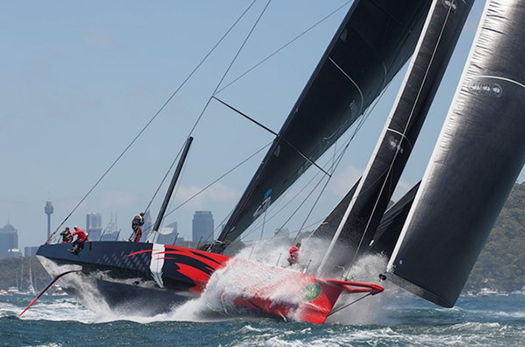
The moment of glory – the mighty Comanche roaring down Sydney Hobart at the start to log a record time to the first turning mark. Photo: Rolex/Daniel Forster
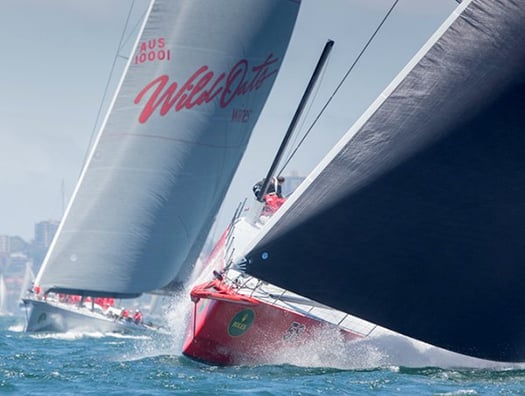
No two ways about it – Comanche is clear ahead of Wild Oats XI approaching the first mark. Photo: Rolex/Daniel Forster
But out at sea, with winds strengths varying but mostly from the south for the first day or so, different stories begin to emerge. A grand sunny southerly sailing breeze may provide lovely sailing and pure spectacle in Sydney Harbour. But get out into the Tasman Sea to head south for Hobart, and you find that the wayward south-going current – always a crucial factor in the early stages of the race to Hobart – can be going great guns and making mischief as a weather-going stream, kicking up a steep sea which can be boat-breaking when that last ounce of performance is being squeezed out.
And as previewed here on December 20th, up among the hundred-footers they've been pushing the envelope and then some in boat development and modification. In new boat terms, the mighty and notably beamy Comanche has gone about as far as they can go for now. But with the likes of the former Lahana reappearing as Rio 100 with a complete new rear half, and Syd Fischer's Ragamuffin 100 simply cutting away the hull for replacement with a complete new body unit while retaining the proven deck and rig, we're sailing right on the edge in terms of what the weird mixtures of new and old build can combine for combat when the seas are steep.
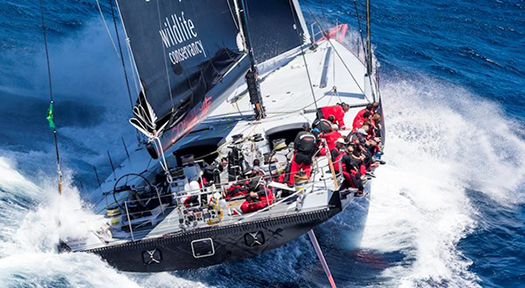
Comanche's wide beam gives added power when there's plenty of breeze......Photo: Rolex/Carlo Borlenghi
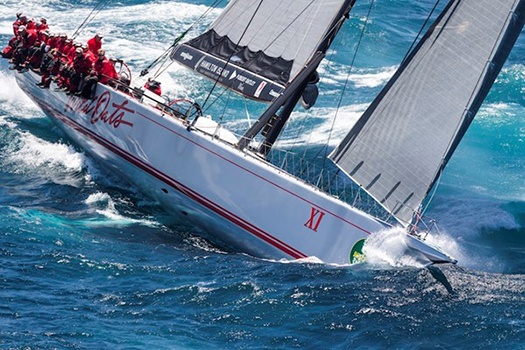
....but the narrow Wild Oats XI can be as slippery as an eel when the head seas get awkward, and when the wind eased she got through Comanche and into an extraordinary 40 mile lead on the water. Photo: Rolex/Carlo Borlenghi
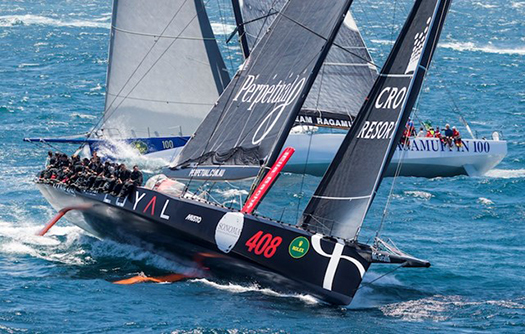
Not all boats revelled in the bone-shaking conditions of the first hundred miles of beating. Perpetual Loyal (foreground) had to pull out with hull damage possibly caused by an object in the water, but the irrepressible Syd Fischer's Ragamuffin 100 (beyond), with a completely new hull, continued going strong to the finish and was third in line honours Photo: Rolex/Carlo Borlenghi
But this glorious element of larger-than-life characters with boats that are off-the-wall is now an integral part of the RSHYR, which manages to attract an enormous amount of attention thanks to its placing in the midst of the dead of winter in the Northern Hemisphere, while in Australia much attention focuses on what is in effect an entire and familiar maritime community racing annually for the overall handicap prize.
Yet though the course is simple, it's deceptively so. Just because it's mainly a straight line from one harbour to another doesn't mean there aren't a zillion factors in play. And as the race gets so much attention, few offshore events of this length are so minutely analysed, and the first 24 hours provided a veritable laboratory for seeing the ways different boats behave in different wind and sea states with the breeze on the nose.
Thus Wild Oats XI has always had a formidable reputation for wiggling her exceptionally narrow hull to windward in awkward seas for all the world like a giant eel, and the early beating saw her doing that very thing, hanging in there neck and neck with Comanche. Despite her beamier hull, Comanche rates slightly lower than Wild Oats. But if a lull with its leftover sea arrived, her greater volume would become a liability to performance, whereas if the breeze got back to full strength, and particularly if it freed the two leaders, then Comanche would be firmly back in business.
But it was not be. Crossing the Bass Strait with Wild Oats right beside them, Comanche's crew saw their navigator Stan Honey emerge on deck and approach Kenny Read with a thoughtful expression on his face, and an ominous little slip of paper in his hand. It was the latest weather print-out, and it wasn't happy reading for a big wide boat that needs power in the breeze. Before expected brisk winds from the north set in, they'd to get through the lighter winds of an unexpectedly large and developing ridge.
Almost while they were still digesting this bit of bad news, Wild Oats started to cope much better with the lumpy leftover sea, and wriggled ahead of Comanche in her classic style. And the further she got ahead, the sooner she got into increasingly favourable wind pressure. As Read put it after the finish: "For twelve hours, conditions were perfect for Wild Oats, and they played a brilliant hand brilliantly".
Amazingly, the old Australian silver arrow opened out a clear lead of an incredible forty miles before conditions started to suit Comanche enough to start nibbling at this remarkable new margin. And fair play to the Read crew, at the finish they'd made such a comeback that Wild Oats was only something like 49 minutes ahead. But even with the new American boat's slightly lower rating, she was beaten on handicap too, and in the final rankings Wild Oats showed up as having line honours overall and a commendable 5th on IRC in Division 0 - and we shouldn't forget she won the overall handicap honours back in 2012 anyway.
But for 2014's race, for a while it looked as if it might be the Cookson 50s again for the overall win. But although last year's Tattersall's Cup winner, the Cookson 50 Victoire, at first took the Division 0 win with her sister-ship Pretty Fly III second, they were so close that when Pretty Fly got 13 minutes redress for an incident with the Ker 46 Patrice in mid-race, it reversed their placings.

It all came good in the end....after being initially placed second in Division 0, the ten-year-old Cookson 50 Pretty Fly III got 13 minutes of redress for an adverse incident during the race, and that bumped her up to the Division 0 win.
Either way, it was still Cookson 50s imprinted all over the sharp end of Division 0. But they were slipping in the overall rankings, where it was boats in the 40-45ft range which were settling into the best combination of timing and conditions to take the Tattersall's.
And plumb in the middle of them was the First 40 Breakthrough, with her strong Dublin Bay Sailing Club input from the Irish team led by Barry Hurley. Fortunes wax and wane with astonishing volatility as the Hobart race progresses, but gradually a pattern emerges. So though at one stage Breakthrough was showing up only around 30th overall, equally she'd a best show of third.
And all around her on the water were similarly-sized and similarly-rated boats with their race-hardened crews knowing that with every mile sailed and every weather forecast now fallen favourably into place, things were looking better and better for this group to provide the overall winner.
It was a very race-hardened crew which came out on top. It was way back in 1993 that Roger Hickman got his first Sydney Hobart Race overall win in an eight year old Farr 43 which was still called Wild Oats, as original owner Bob Oatley hadn't yet reclaimed the name for ever bigger Grand Prix racers. When he did start to go down that road, the 1985 Wild Oats became Wild Rose, but "Hicko" still owns her. And by the time the Rolex Sydney-Hobart Race 2014 started, he was doing it for the 38th time. He went into it as current Australian Offshore Champion, now he has won the big one on top of all that. Some man, some boat.
The slightly higher-rated Breakthrough was pacing with Wild Oats for much of the race, but as Barry Hurley's report for Afloat.ie told us with brutal honesty, somewhere some time they got off the pace. If you didn't know already of Barry's remarkable achievements - which include a class win in the single-handed Transatlantic Race and the more recent Middle Sea Race success – you would warm to the man anyway for the frankness of his initial analysis of why Breakthrough slipped from being a contender to 12th overall and – more painfully – down to 7th in their class of IRC Division 3.
He promises us more detailed thoughts on it in a few weeks time, something which will be of real value to everyone who races offshore, for the race to Hobart is a superb performance laboratory. And maybe we can also hope in due course for further thoughts from someone on whether or not Matt Allen's Carkeek 60 Ichi Ban, skippered by Gordon Maguire with Adrienne Cahalan as navigator, has what it takes to be a killer.
It's easy for us here in Ireland to look at screens of photos and figures and reckon that Ichi Ban is just a little bit too plump for her own good. But Maguire has twice been key to a Sydney-Hobart overall win, the most recent being in 2011 with Stephen Ainsworth's Loki. And Cahalan's record of success as a navigator/tactician is almost without parallel. Yet though Ichi Ban's 2014 Hobart race score of 8th in line honours and fourth in IRC Division 0 is a thoroughly competent result, it just lacks that little bit of stardust.
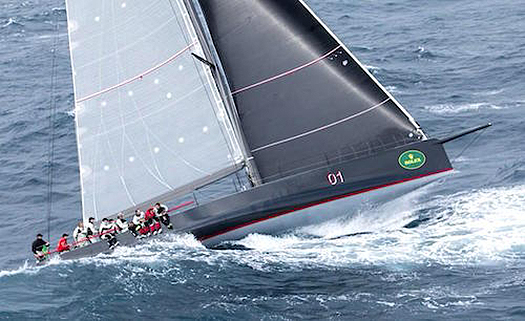
Ichi Ban finding her way through the waves on her way to Hobart. If that's not a spare tyre around her midriff, then what is it?
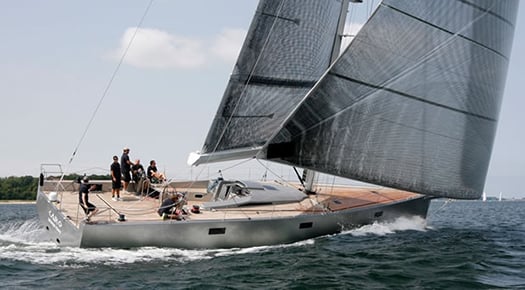
Despite being a "racer/cruiser", the Botin 65 Caro – navigated by Ian Moore – pipped Ichi Ban for third in class.
With the next Rolex Sydney-Hobart Race just over eleven months down the line, let's hope we're proven utterly wrong within the year on the Ichi Ban question. But the whole matter is pointed up by the fact that the boat which pipped in ahead of her in the IRC Div 0 placings in third place behind the two Cookson 50s was the Botin 65 Caro, with our own own Ian Moore navigating on this 65 footer which likes to emphasize her dual role as a racer-cruiser.
Now there really is food for thought. But in this first weekend of this wonderful new year of 2015, let's remember some of the events of December 1991 as recorded in excited detail in the Afloat magazine of Feb/March 1992.
On the cover is Meath-born John Storey's Sydney-based Farr 44 Atara, around which the Irish Southern Cross team of 1991 was built, as Harold Cudmore was aboard, and he brought out John Mulcahy from Kinsale and John Murphy from Crosshaven.
The small boat of the team was Tony Dunne's Davidson 36 Extension – the owner claimed Irishness through the Irish granny rule, but the matter was put beyond any doubt by Joe English being on board with Dan O'Grady and Conor O'Neill. And then for the third boat they'd Warren John's Davidson 40 Beyond Thunderdome, whose owner was happy to be Irish if they'd let him, and to put the matter beyond doubt his vessel was over-run by Howth men in the form of Gordon Maguire, Kieran Jameson, and Roger Cagney, with Dun Laoghaire's Mike O'Donnell allowed on board too, provided he behaved himself.

In the Southern Cross Series of 1991, the Davidson 40 Beyond Thunderdome was raced for Ireland by Gordon Maguire and Kieran Jameson. Thunderdome was top of the points table when she was knocked out with a dismasting in the final inshore race, and was unable to race to Hobart.
It was an accident-prone series, with Beyond Thunderdome dismasted in a tacking collision with one of the Australian boats with just three days to go to the start of the Hobart Race. There simply wasn't time to get a replacement mast, let alone tune it, but at the last minute the jury decided the Australian boat was at fault, and allowed Beyond Thunderdome average points not only for that race in which she'd been dismasted, but also for the Hobart Race which hadn't even yet been sailed.
In a final marvellous twist to the story, as Thunderdome couldn't race to Hobart, Gordon Maguire was drafted aboard Atara to add helming strength for the big one. Atara had only been a so-so performer until the big race. But Cudmore and Maguire – that really was the dream team. And it gave the dream result. Atara won the 1991 Sydney-Hobart race overall by a margin of one minute and 50 seconds. It was one of the closest results ever, but it was a close shave in the right direction for Ireland. The Irish party in Hobart to welcome 1992 was epic. And Gordon Maguire's sailing career was set on a stellar course.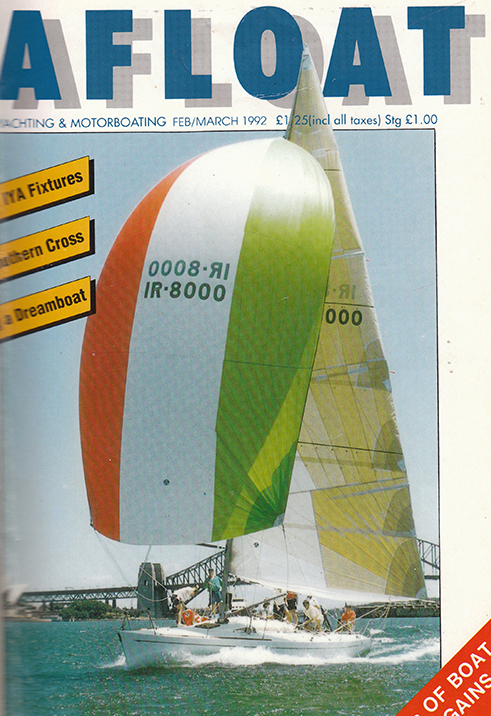
Our magazine edition of February/March 1992 cover-featured John Storey's Farr 44 Atara, overall winner of the 1991 Sydney-Hobart race with the dream team of Harold Cudmore and Gordon Maguire on board to give Ireland the win in the Southern Cross Series.
Posthumous Irish Cruising Club Award for Joe English
#icc – At the Annual Dinner of the Irish Cruising Club held at the Royal Cork Yacht Club last Saturday night its Commodore Peter Killen presented the John B. Kearney Cup to the family of the late Joe English together with a citation which read as follows:
The John B. Kearney Cup: Awarded for outstanding contributions to Irish sailing:
To Joe English for an outstanding career as a word–class sailor sailor. He skippered NCB Ireland in the Whitbread Round The World race in 1989-90, took part in the same race on 'Tokio' in 1993-4, participated in many Admiral's Cup races and was involved in a winning America's Cup team. In 1979, while based in Sydney he competed in several major events including the Southern Cross and Kenwood Cup series. In 1980 he won the one ton sailing cup with Harold Cudmore on the Tony Castro designed 'Justine' and also won the two ton cup in Sardinia a week later. Joe was central to the development of the 1720 sportsboat. Diagnosed with early onset Alzheimers disease at age 51, he died at age 58 on November 4th, 2014.
Joe's wife, April, and son Robbie accepted the award on behalf of the family.
Joe English RIP
#joeenglish – Joe English of Cork, who commanded Ireland's Round the World challenger in the 1989 Whitbread Race and subsequently skippered 'Tokio' in the 1993 round the world event, has died at the age of 58 after a seven year battle with illness.
Joe was "The People's Skipper", an immensely popular sailor of international standing who always remained a Corkman through and through. He was an asset on any boat at every level, and the fact that he could switch from the demands of Volvo racing to cruising with his family and friends, both long distance and on his beloved Cork coast, speaks volumes for his qualities as a man, as a husband and father, and as a sailor.
He learned his skills afloat as a young boy from the family home in Cobh, and through increasing involvement with the Royal Cork YC on the other side of Cork Harbour in Crosshaven. His professional career in sailing started thirty-eight years ago, when he joined the staff of the newly established North Sails Loft in Kinsale in 1976, and his life path thereafter saw the development of abilities which stood him in good stead in any area of sailing with which he became involved.
Thus it was typical of Joe that, in addition to his stellar international offshore racing career, in 1994 he was closely involved on the shores of Cork Harbour with the inauguration of the 1720 Sportsboat project with designer Tony Castro.
In the seventies, Joe and his brother Eddie were amongst the first recruits to the new Irish Yachting Association (IYA) Junior training programme and Joe competed in both Cadet and National 18 dinghies. He won the IYA Junior Helmsman's championship with Neil Kenefick in 1974 and represented Ireland at the IYRU Youth World Sailing Championships in Largs, Scotland the following year.
He first competed in the Admiral's Cup in 1977 on 'Big Apple' owned by Clayton Love, Hugh Coveney and Raymond Fielding leading up to the infamous 1979 Fastnet Race with Denis Doyle on Moonduster.
Joe moved for a time in the late 1970s to Australia, where he was based in Sydney and competed in various major events. He returned to Cork harbour in 1981, where he won the One Ton Cup sailing with fellow Cork sailor Harold Cudmore on Frank Woods' 'Justine III'. They won all five races in a light airs series and then followed this with victory in the two-ton cup in Sardinia a year later.
Joe's position as one of the greatest and most popular of Ireland's sailors was firmly established a home and abroad when he was given the cruel news of early onset Alzheimer's disease in November 2007 at only 51 years of age. The devastating diagnosis came after he had been struggling with memory issues for some time, resulting in his retirement from fulltime employment in May 2006.
In response to this situation, the Joe English Trust (JET) was formed by many of his sailing friends to help care for him. The trustees of the fund are Richard Burrows, Tom Roche, Neil Kenefick, John Crotty, and John Bertrand. With typical fortitude, Joe and his wife April had courageously taken part in a very frank television documentary which brought home to everyone in Ireland, sailors and non-sailors alike, just how devastating early onset Alzheimers can be. Yet the programme also provided inspiration by showing the brave way in which they faced a situation which could have only one conclusion, and it added further to the admiration in which this remarkable couple were held in Cork, in Ireland, and throughout the sailing world.
Our thoughts are with April and Joe's family and his many close friends at this very sad time.
Funeral arrangements are as follows. Reception into St. Brigid's Church, Crosshaven, on Wednesday at 6.30pm. Requiem Mass on Thursday at 11.30am. Funeral afterwards to St. Patrick's Cemetery, Crosshaven. Arrangements in full are posted here.
Cobh-Blackrock Race Raises Funds for Joe English Trust
#cobhtoblackrokrace – 80 boats of all shapes and sizes competed in yesterday's Cork Harbour Cobh to Blackrock race sponsored by the Port of Cork and Union Chandlery and hostedy by Cove Sailing Club.
The "all-in" start for 60 cruisers off the Cobh line was exciting both for the spectators and crews alike.
After racing 40 ribs and boats rafted up at the City Quays marina and a big crowd gathered at the Boardwalk Restaurant for the prize-giving and popular barbecue.
A raffle held after the prize-giving raised a massive €650 for the Joe English Trust.
29 Compete in CH Marine Winter League
A very good fleet of 29 cruisers came to the line for the first day of the CH Marine Winter league writes Claire Bateman. The first radio sound to be heard was the familiar voice of Afloat correspondent Tom MacSweeney, who was PRO for the occasion, advising the course to be sailed would 99, sailing Classes One and Two together and Classes 3 and White Sail also together. An equally well known voice came back wondering whether there would be water at one particular mark!!
The sea was flat and there was a fitful wintery sun. In spite of the dire forecast that had been promised, one could have been doing a lot worse than enjoying a race in Cork Harbour.
The course turned out to be a good choice as it is divided into three parts and could be shortened after any one of the three rounds. The wind from the ESB stack at Whitegate was showing north west, Met Eireann report from Roches Point was giving 5 knots from the west and the Race Officer for the Laser fleet was setting a course for a south west wind. It was that kind of day.
It was an off wind start and True Penance with Joe English on spinnaker got the best start with End Game just behind with Jimmy Nyhan trimming the spinnaker, and Bad Company was looking good as well on the shore side. Magnet was throwing all sorts of shapes at the cage but a was bit slow hoisting her spinnaker.
Classes Three and White Sail sailed one round of the course and Classes One and Two got in two rounds. This worked out very well because as the race progressed the tide was getting stronger and this helped the boats to make it out the harbour against the tide so it all jelled very well.
The prize giving followed at which CH Marine presented the competitors with very seasonal and acceptable bottles of wine and boxes of Cadburys Roses and immediately afterwards the threatened rain began to pour down but as this stage the competitors were not bothered as they were ready to go home having enjoyed a great day of racing.
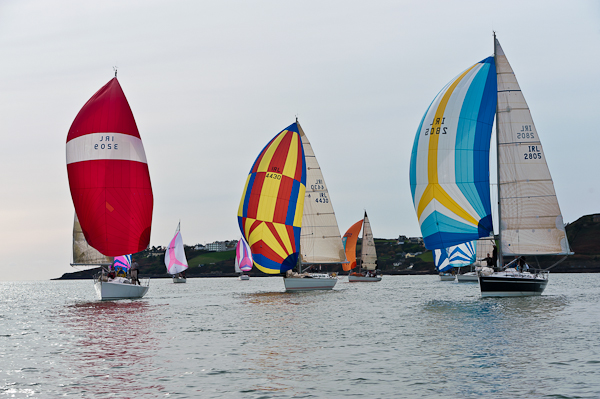
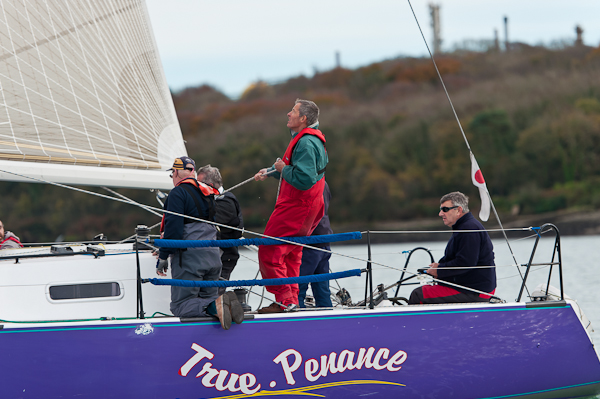


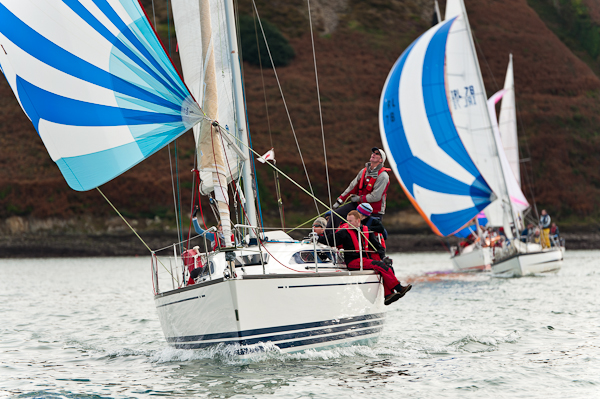
Photos by Bob Bateman
Joe English Lunch in Howth Yacht Club
Howth Yacht Club is staging a lunch to help Round the World skipper Joe English who has been diagnosed with Alzheimers disease according to a note on the club website.
Coming from a career in sailing that started in 1976 in North Sails' Kinsale loft, Joe is probably best known for his role as Skipper of NCB, the Irish maxi yacht which competed in the 1989 Volvo Ocean Race.
He also took over as Skipper of Toshiba in the 1997 race. More locally, Joe was an innovator in the Cork 1720 project in conjunction with Tony Castro.
In recent years, Joe has been diagnosed with Alzheimer disease at a very young age and recently featured in a Prime Time documentary on RTE on the subject. A charitable trust has been launched to help Joe and his family over the coming years and this year's HYC Christmas lunch is to benefit this worthy cause.
The lunch is on Friday, 10th December




























